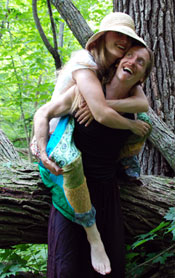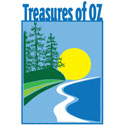It’s starting to look a lot like spring here in Wisconsin, with temperatures reaching 40 degrees F during the day. For Rebecca and I, that means it’s time to take the shoes off!
Some people think it’s weird that we enjoy going barefoot, but for us there is nothing quite like the feel of leaves or grass or stone (or yes, at this time of the year, even snow!) underfoot. Unconstrained by shoes, your toes can wiggle gloriously, and you get to feel the tendons and muscles of your feet moving and flexing after they’ve been stuck immobile in shoes and boots all winter long.
Some experts are beginning to suggest that shoes aren’t all they’re cracked up to be. In the book Born to Run, by Christopher McDougall, the author cites numerous studies that show that wearing high-tech running shoes, for instance, actually increases our risk of injury. It turns out that our feet are marvelously designed, and that most foot problems might actually be caused by our shoes, which effectively act like casts on our feet, restricting movement (think muscle atrophy and reduced flexibility), cutting us off from the ground, and creating a moist, dark, hot environment perfect for growing fungus and other interesting organisms. In other words, we think our feet are tender, weak, and ill-designed, but most of us have never given them a chance to build muscle and flexibility. What might happen if we set them free?
Perhaps shoes aren’t actually evil, but Rebecca and I are often happier without. If you begin early in the spring, walking on the pavement where the snow has melted, the bottoms of your feet will become conditioned, and by summer you’ll amaze everybody by being able to run over gravel and go for unshod walks through the woods. After some spring conditioning, I’m able to rock-climb, backpack, and enjoy long-distance runs, all without shoes.
If you’ve never given barefoot a try, we’d encourage you to give it a chance this summer — perhaps on some lush grass — and see what it’s like to experience your toes moving through the green. If you want to try going full-on extreme super ultra barefoot, then now’s the time to kick off those shoes and start walking sans shoes wherever the snow has melted!
The First-Time Barefooter’s Guide to Getting Started
It’s simple. Just take off your shoes. Start around the house, to get some initial conditioning on your soles, and to begin to strengthen the muscles and tendons. Feet that have been cloistered in shoes for a long time have to remember what it’s like to flex, stretch, and wiggle. You’ll be building up strength through your ankles, as well as throughout your foot.
When it’s warm out, try going outside. Soft grass is the best place to begin your outdoor adventures. It’s a marvelous feeling to immerse your toes in grass, and your chances of getting a puncture wound are minimal. If you enjoy this, you can try a little more. Purchase some flip-flops or open sandals, which will let your feet breathe (if you have issues with fungus they’ll soon disappear once you get your feet breathing again). Plus, flip-flops are easy to slip off if you see a path or stretch of grass that beckons.
The Extreme Barefooter’s Guide to Going Shoeless
Purchase yourself some flip-flops or sandals, and unless it’s absolutely necessary, never put on socks or shoes again. (Here in Wisconsin, temps drop so low that at some point you have little choice but to boot up.) I begin conditioning in early spring, walking down our paved country road. I’ll walk on the road itself, venture over to the shoulder, and walk through patches of ice and snow. Sometimes I even sort of scuff my feet or wiggle them in sand. This is all to condition the soles, which will develop soft callouses and will become less sensitive to things.
Then comes the fire. Do this at your own risk, obviously, but I’ve found that if I warm the bottoms of my feet over the campfire (as I would my hands), and then give them small doses of hotter temps, my feet seem to quicken on their way to getting barefoot-ready.
Next comes jogging. I find that my gait is naturally different (no heel strikes) when I run barefoot, and by doing short distances I begin to build foot strength and flexibility. After that it’s a process of gradually adding more running distance and more extreme terrain. A month after training begins, I can go almost anywhere that I’d wear shoes (except into nice restaurants and such, which seem to frown on the practice =)
For the Rest of Us
One last option is to try some of the new ‘minimalist footwear’. Perhaps the wackiest, funnest, and most well-designed are Vibram Five-Fingers, which are ‘shoes’ that have toes. These still have the disadvantage of keeping your feet in a hot, moist environment, and they don’t allow your soles to condition (they also reduce sensation), but at least they allow your feet to stretch, wiggle, and interact with their environment. Of course, people will look at you very strangely when you wear them, since they are quite unlike any other footwear around.
If you do give bare feet a try, enjoy! Your feet will probably thank you =)
Posted on March 4th, 2010 by Kenton Whitman
Filed under: Getting Outdoors




Your post brought back memories of when I was a kid and went barefoot all summer long. We lived on a dirt road and at first I would mince ow! ow! ow! every time i had to cross it, but after a few weeks I could even run on sharp gravel without any pain. I’m afraid it’s a bit too cold and muddy up here in upstate NY to try barefooting this early. Must be kind of cold in Wisconsin, too!
You give some great advice and pointers, especially this: “Feet that have been cloistered in shoes for a long time have to remember what it’s like to flex, stretch, and wiggle. You’ll be building up strength through your ankles, as well as throughout your foot.”
How true. This is especially important to remember with all the interest in barefoot running. Just as someone who hasn’t lifted much more than a fork for several years can’t reasonably expect to go into the gym and bench-press 300 pounds within the first few days, neither can someone who is used to keeping their feet in shoes and socks (or even sandals) expect to be able to run barefoot with no pain and a lot of pleasure until they begin to reawaken and strengthen their feet.
For people who spend a lot more time in shoes than out of them (sleep doesn’t count!), it is very helpful to get in some “recalibration” barefoot time before running without shoes.
Click on the name “Barefoot Hiker” above to read an article on barefoot hiking, with original photos.
I too have enjoyed walking barefoot in the past though I have had some nasty accidents as a result including a pine needle in my heel which put me out of action for some time. One alternative worth considering are the Vibram Five Fingers shoes which allows your feet to move like normal but protect your sole a little. I know it’s not quite the same feeling that cool, damp grass between your toes, but they do offer you a little protection.
Hi Jackie!
Glad this could bring back some memories. Those first barefoot steps in the spring can be tender indeed!
It is still cold here, but it sounds like you got hit much harder than us this year with heavy snows and quite a powerful winter. Our roads are mostly clear, and the old blacktop is pretty warm on bare feet. Can’t wait until the snow is gone and the toes can start crinkling through leaves and sticks!
Hi Barefoot Hiker!
Glad to meet more barefooters! That article you link to is great — thanks for providing the resource. Also, thanks for the reminder to take it easy at first, especially when trying running. Shod feet definitely need some time to build strength.
Hi Richard,
Thanks for the reminder about Vibram Five-Fingers. They can really save your feet some punishment if you’re going over unforgiving terrain. Especially here in the north, it’s difficult to keep feet conditioned year-round since the cold begs for boot and shoes in the winter-time. I’ll use footwear that gives my feet wiggle-room (like mukluks), but the soles still get soft.
I suppose not even shoes can save us from some punctures. I remember two years ago looking at a thorny patch of ground and deciding to put on some sandals before I negotiated it. One of those huge thorns went right through the rubber sole and into my foot. Getting your foot out of a shoe when the thorn is still in there is not very pleasant! =)
Enjoy your barefooting and Five-Fingering!
This is so true and useful and just so refreshing to read. Love how you see things and so kind of you to share with us!
We were recently at a huge Organic Conference in Lacrosse and besides all the wonderful food and cool folks and all the learning, one farmer dude had those shoes on that you mentioned and I just thought they looked so comfy and now I see where I can find some—thank you for that too!
How long do you usually go rockclimbing for? I usually make a day long affair of it.
Hi Jay!
Interesting that you’ve seen some Five-Fingers in action. Most people have never heard of them, let alone seen them! That look pretty interesting, don’t they? =) The indoor climbing wall we go to doesn’t allow bare feet, so we’re going to get some Five-Fingers and try them on the wall, so we’ll let you know what we think.
Hey rockclimbing,
We do too, especially as we usually have to drive a bit to get to really nice rock faces. We’re also lucky to have a great indoor wall at the university in town, so for some indoor fun, we just pop in for a couple hours.
Great post! I would love to read writings that talks about barefooting. This is a big help to a novice barefoot runner like me. Thanks for sharing!
Hi Sand Sock Girl — Glad it can be of help - keep up the barefooting! Yipeee!